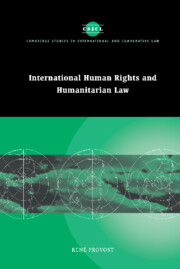Book contents
- Frontmatter
- Contents
- Acknowledgments
- Table of cases
- Table of treaties
- Table of other international instruments
- Introduction
- PART I Normative frameworks
- PART II Reciprocity
- PART III Application: law and facts
- Introduction
- 6 Areas of legal indeterminacy
- 7 Legal effect of characterisation
- Conclusion to Part III
- General conclusion
- Bibliography
- Index
- CAMBRIDGE STUDIES IN INTERNATIONAL AND COMPARATIVE LAW
Conclusion to Part III
Published online by Cambridge University Press: 07 September 2009
- Frontmatter
- Contents
- Acknowledgments
- Table of cases
- Table of treaties
- Table of other international instruments
- Introduction
- PART I Normative frameworks
- PART II Reciprocity
- PART III Application: law and facts
- Introduction
- 6 Areas of legal indeterminacy
- 7 Legal effect of characterisation
- Conclusion to Part III
- General conclusion
- Bibliography
- Index
- CAMBRIDGE STUDIES IN INTERNATIONAL AND COMPARATIVE LAW
Summary
The characterisation of situations as armed conflicts under humanitarian law and as states of emergency under human rights law raises, at a basic level, the same problem: how to assess the legal character of these situations in the presence of characterisations which are often numerous, usually contradictory, and sometimes legally unfounded? The difficulty is one that affects international law as a whole, leading states to rely on their own appreciation of whether there has been a material breach of a treaty before suspending it, whether a norm has been violated before adopting countermeasures, or whether there has been an armed attack before acting in self-defence. That being said, the fact that indeterminacy affects all of international law does not mean that a universal solution can be found. As this entire book has sought to show, different areas of international law will have distinct normative dynamics, calling for a modulated response to the challenge of indeterminacy. Thus a number of significant differences between characterisation of situations under human rights and humanitarian law have emerged in the course of the preceding analysis. These differences stem from both the context of application and the nature of norms in human rights and humanitarian law.
First, characterisation of a situation as an armed conflict necessarily implies the possibility of competing autoqualifications by the various belligerents. Even in the case of an internal conflict, international law grants insurgents a measure of functional sovereignty whereby they are entitled to make a valid legal characterisation of the conflict.
- Type
- Chapter
- Information
- International Human Rights and Humanitarian Law , pp. 338 - 342Publisher: Cambridge University PressPrint publication year: 2002

